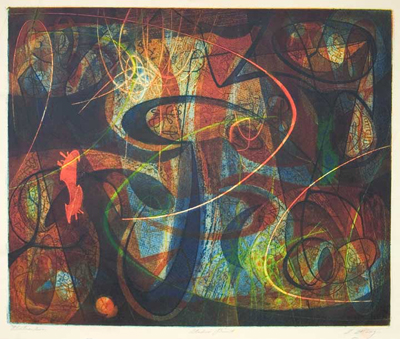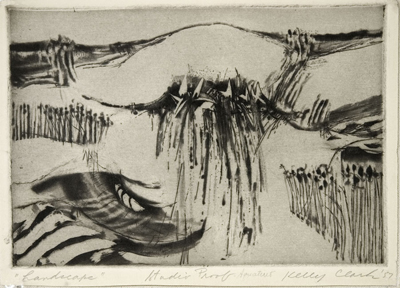Ted. Howorth and William Pura
10 Roslyn Cres.
Winnipeg, MB., Canada R3L 0H7
204 452-7566
thowrth@cc.umanitoba.ca
Proposal Website: www.umanitoba.ca/schools/art/content/galleryoneoneone/print.html
This contains an essay that briefly describes the nature of these and other works that might be included in a presentation. There are also links to 59 works that were created in the 50s prior to the revival of printmaking that occurred with collaborative printmaking in the 60s and 70s.
Paper: “Border Crossings: Canadian Prairie Regionalism in Printmaking”
As a major urban center of the Canadian west, Winnipeg opened its School of Art in 1912. The hard bitten nature of the people, weather and geography created an aesthetic that reveals itself in the attitudes of printmaking that have developed over the years of its existence.
Winnipeg developed a strong history of printmaking with many local artists combining their work in the commercial graphic arts with their own fine art pursuits. Three major players in Canadian Art during the first half of the Twentieth Century were the water based Japanese style wood block printing of Walter Phillips, the more Euro-based wood engraving style of Eric Bergman and the etchings and linocuts of L.L. Fitzgerald. For many years Fitzgerald was the head of the Art School. As the only western member of the Canadian Group of Seven artists, Printmaking was an important part of his artistic output.
By the1950’s printmaking was already an important element of the artistic community, but its intense development over the next decade was an indication of how well process and the regional aesthetics had converged in the prairie environment. This intense development was due in part to the arrival of a new director and three other artists/teachers from the University of Iowa. All had studied with Mauricio Lasansky resulting in a very strong opinion on the kind of printmaking taught at the School and the importance of printmaking in its curriculum. The harsh prairie geography and climate mixed with the laborious, physically challenging activity of copper etching combined to create a hotbed of strong, dark imagery.
This cultural hybrid preceded the influences that shaped much of North American printmaking during the 1960s and 1970s. The new printmaking energy that came out of workshops such as ULAE, Tamarind and the French Canadian master printmakers of Quebec had not yet arrived to change the look and attitudes of printmaking throughout North America.
In Winnipeg, the mix of the sense of space found in the boundless prairie landscape, the influence of climate, the importance of the land in relation to the urban setting, the importance of figurative work, of drawing and of the act of physical printmaking as well as the new influences from Europe and New York produced work with an edginess, freshness and sense of commitment often found in things newly discovered.

The work we would like to discuss is drawn from the archives of the School of Art from the 1950’s. Many of these young artists went on to important national and international careers. These images offer a look at printmaking from a regional perspective exemplifying the people and mythology of the Canadian prairies when prints and printmaking were thought of in a very different way than now.
Regionalism is an important force in the global context of art making and this body of work offers a look into the transposition and integration of ideas from other cultures and how there influence can develop a hybrid in areas that were quite distant geographically.
The effect of subjective educational influence has maintained itself to become a strength in the tradition of how art is made in this region of the Canadian west. This archive offers an example of the importance of curatorial practice in showing us from where we have come.
Our presentation could take the form of displaying actual work, slides or a powerpoint presentation of images from the collection with discussions around aspects of technique, subject matter and how they developed in relation to the prevailing aesthetics of the time.

Note from Ted Howorth: I am wondering where we go with this process from here. In reading some of the other proposals I can see links that might work well together such as our 50s aesthetic in relation to "The Collaborative Shift" in the 60s / 70s as mentioned in Kerry-Lyn Honey's proposal.
__________________________________________________________________________________________________
Ted Howorth Biography
After receiving his Bachelor of Fine Arts from the University of Manitoba in 1969, Ted Howorth embarked on a professional career in art, specializing in printmaking. In the 1990s Howorth returned to school, receiving a Masters of Fine Arts from the University of North Dakota. In 1995 he was appointed to the Royal Canadian Academy of Arts, R.C.A.
E.J.Howorth's work has been inspired by study of traditional Japanese wood-block printing under Noboru Sawai and through apprenticeship under Wilfredo Arcay at the prestigious Atelier Arcay in Paris in 1979. Currently Howorth’s work attempts to bridge the worlds of digital and traditional printmaking, combining inkjet and screen printing in the creation of visual narratives.
In the 1990s he was invited by Michael Schönke of Druckwerkstatt/BBK to assist in introducing water-based screen printing techniques at the print studio in Berlin, Germany. Howorth has a long-standing association with Open Studio in Toronto, Canada’s foremost print atelier and the Manitoba Printmakers Association in Winnipeg.
Over the past 30 years, Howorth has exhibited in many International Juried Print Biennales. He was a medal winner in the International Grafik Biennial Freschen, West Germany. His work has been shown in solo and group exhibitions at the Winnipeg Art Gallery; the National Gallery of Canada; the Musee d’Art Contemporain in Montreal and the Grand Western Canadian Screen Shop Show at the Canadian Cultural Center in Paris. He has had solo exhibitions in Winnipeg, Toronto and Montreal.
E.J. Howorth has received numerous grants, government commissions producing one-of-a-kind murals and commemorative limited edition prints for the Canadian Institute of Planners (1994), Pan-Am Bid Committee (1994) and the Regional Commonwealth Conference Parliamentary Association (1986). His work is part of private, corporate, university and government collections throughout Canada, USA, France, England, Australia and the British Commonwealth in the Americas.
E.J.Howorth is currently a Full-time Lecturer in Printmaking and Drawing at the School of Art, University of Manitoba, Winnipeg, Canada.
William Pura Biography
William Pura received his Bachelor of Fine Arts from the University of Manitoba and his Master's degree from Indiana University. He is currently a professor at the School of Art University of Manitoba where he teaches both printmaking and painting.
With training in both music and visual art, he has undertaken diverse projects making use of traditional media as well as electronics, computers, video and other multi-media combinations.
His art and music have been performed internationally in Europe, the U.S. and throughout Canada.
Besides working in traditional printmaking media he has also produced works blending his visual art imagery with music and dancers. Some of these pieces have been distributed through DVD and CD.
He is currently a member of the Canadian Music Centre (www.musiccentre.ca) and the American Composer Forum (www.ComposersForum.org) as well the Manitoba Printmakers Association.